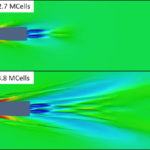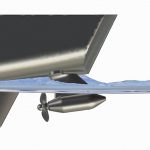The ability to adapt to new situations, changing needs or altering conditions, is crucial for survival. It forms the basis of evolution. In the simulation business, this can mean new flow conditions in a CFD simulation or changing customer demands in terms of massively parallel hard- and software. Wherever the challenge for organisms, individuals, organisations or software codes comes from – adaptivity is the key.
Technical adaptivity in marine CFD is accomplished by adapting the numerical accuracy to the demands of the flow physics. Accuracy[ds_preview] is expensive to achieve, let it be the scheme or the grid resolution. Therefore it makes perfect sense to be as accurate as needed – but not more. For a CFD simulation this means that flow gradients, be it in space or time, must be resolved by a sufficient amount of grid points and time steps. Two prominent examples for high gradients are the boundary layers on ship hulls or on propeller blades with their high velocity gradients and the free surface, where the density abruptly changes by a factor of thousand.
Today, FINE/Marine is the only CFD code which has been specifically designed with marine applications in mind and which also features powerful adaptation routines. FINE/Marine works on unstructured hexahedron meshes created by »Hexpress«, which allow for an easy and robust adaptation. The adaption itself is triggered by the flow solver ISIS, a volume of fluid (VOF) »Ranse« code capable of full 6 degree of freedom (6 DOF) body motion. The adaption itself is triggered by several criteria, such as Free Surface, Gradient or Hessian Criteria. All these criteria can be combined or executed successively.
The efficiency of adaptive mesh refinement is highlighted in the image. In this case, a high speed vessel propelled by water jets, the wave pattern is the quality criteria of a CFD solution. Here, the adapted mesh has only about 40% more cells than the initial mesh. This is only a very modest price, if one considers the much more detailed wave pattern in the adapted solution. Features such as the interaction between the water jets and the stern wave are not visible in the original solution, but do stand out clearly after adaptation. The waves travel far farther through the domain, eventually leading to a very accurate solution, at very reasonable costs. Without adaptivity, instead of just 40% more cells, about 3 to 5 times of the original mesh cell count would have been required – still without a priori knowing where to place them.
HPC – and parallelisation
High level CFD simulations in the maritime field are challenging due to very expensive features. Examples are:
6 degree of freedom (6 DOF) multiple body motion.
Wave breaking and splashing.
Full unsteady simulations and sliding grid computations of rotating propellers.
Acceleration and dynamic positioning.
Seakeeping and self-propulsion.
Optimisation.
In order to deal with these high computational demands, High Performance Computing (HPC), and along with it, parallelisation is the key. Full (or more realistically nearly full) and automatic parallelisation is therefore a highly important property of a CFD code. But parallelisation of adaptive grids is not obvious since the workloads of each processor may change after each adaptation step. FINE/Marine automatically and dynamically distributes the changing load requests due to refinement over the hardware architecture. So, an optimum usage of all CPU cores is guaranteed at all times.
Business adaptivity
The commercial viewpoint is similar to the numerical one: Only use, provide and pay for what is really needed. In times of high workloads maxed out licenses are quite common, while in other times expensive software licenses are idling. The same holds true for the massively parallel hardware needed for high level CFD simulations. In any case, if future CFD requirements are to be met, users will find themselves in a situation, where they have to invest in large hardware and in licenses. How to ensure that these investments will pay off?
One viable avenue is to employ an external provider, who ideally has dozens or hundreds of clients and can therefore exploit the averaging effect. It is statistically highly unlikely, that all his clients have their up- and downtimes at the same time. Key issues of such a concept are of course security and availability on very high levels. Equally important are high computational performance and a transparent scheduling and workload sharing. CPU 24/7 is one such provider who offers Hard- and Software as a bundle. Due to their long experience and expertise, all the issues aforementioned are dealt with. Numeca offers in cooperation with CPU 24/7, the so-called »Numeca On Demand« concept. It combines freely scalable HPC resources with an on-demand license management for FINE/Marine. This concept fulfils the requirements regarding dynamically changing job characteristics in the same manner as during the adaptation steps of a CFD code.
The entire job allocation, technically as well as commercially, is completed with a couple of mouse-clicks within 10 minutes. In combination, numerical and business adaptivity offer the potential to achieve the high requirements of full featured maritime CFD at a fraction of the cost of the traditional approach.
Thomas Hildebrandt





















